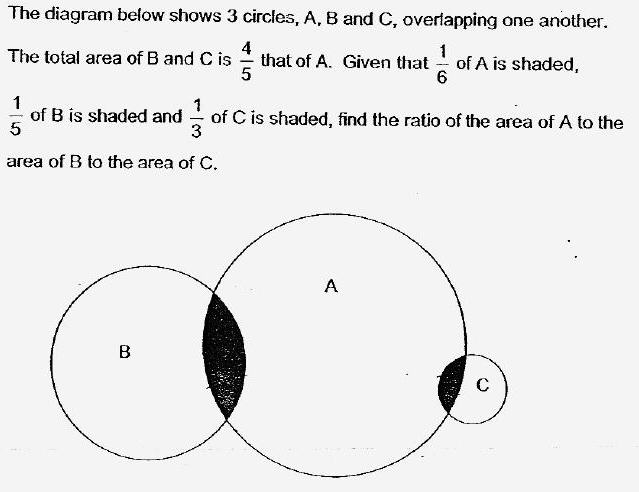Name : ____________________ Date : _____________
Score : _____________
Write down your correct answer and show your workings:
1) There were some
marbles at a shop. The ratio of the number of red marbles to the number
of blue marbles was 2:3.
When 50 more red marbles and 30 more blue marbles were added, the ratio
of the number of red marbles to the number
of blue marbles became 5:6. How many marbles were there at first?
2) There are 600 children
in Team A and 30% of them are boys. There are 400 children in Team B and
60% of them are boys.
After some children are transferred from Team B to Team A, 40% of the children
in Team A and 60% of the children
in Team B are boys. How many children are transferred from
Team B to Team A?
3) Daniel has $160 more than
Alex. After giving 1/10 of his money to Alex, he now has 3 times as much
money than Alex.
How much money do they have in the first place?
4) Packets of assorted
candies were sold in 2 different sizes - standard and large. The large
packet contained twice as many
candies as the standard packet. In the standard packet, the ratio of the
number of coconut candies to the number of strawberry
candies were 4:5. In the large packet, the ratio of the number of coconut
candies to the number of strawberry candies to the
number of toffee candies was 1: 2: 3.
A family bought 1 standard and 1 large packet.
(a) What was the ratio of the number of coconut candies to the number of strawberry candies to the number of toffee candies?
(b)
The family ate 21 candies. As a result, the ratio of the number of coconut
candies to the number of strawberry candies
to the number of toffee candies became 2: 3: 3. How many candies were left?
5)

Answers:
1)
Before adding:
Red : Blue
= 2: 3
= 4: 6
After adding, (based on the above ratio)
Red : Blue
= 4u+50 : 6u+30
= 4u+50 : 6(u+5)
The given ratio, after adding is :
Red : Blue
= 5:6
Compare blue ratio, 6(u+5) = 6
hence, red ratio = 5(u+5)
Equate this to the red ratio found earlier.
5(u+5) = 4u+50
5u+25 = 4u +50
u = 25
At first ,
red marbles = 4u = 4 x 25 = 100
blue marbles = 6u = 6 x 25 = 150
2)
This is a tricky one. The key is : The total number of
boys before and after the movement is the same.
Total boys = (30% x 600) + (60% x 400) = 420
Total girls = (70% X 600) + (40% x 400) = 580
Total = 1000
After movement, in team A
Boys : Girls
= 4 : 6
= 2 : 3
In team A, there are 5units of children.
In team B, there will be 1000 - 5 units of children.
Team B ratio,
Boys : Girls
= 6 : 4
= 3 : 2
= 3/5(1000 -5u) : 2/5(1000 -5u)
2u of boys in team A + 3/5(1000 - 5u) of boys in team B = 420
2u + 600 - 3u = 420
1u = 180
# of boys in team A after movement = 2u = 360
# of girls in team A after movement = 3u = 540
Total in team A = 900.
# of children transferred from team B to team A = 900 - 600 = 300.
3)

4)
Large packet
c:s:t
= 1:2:3
Standard packet
c:s
4:5
Large packet contains 2x as many candies as standard packet.
No. of units (standard packet) = 9
no. of units (large packet) = 9 *2 = 18
therefore, c:s:t = 3:6:9
(a) 1 standard + 1 large, c:s:t = 7:11:9
(b)
before eating : c:s:t = 7:11:9
after eating 21 candies, c:s:t = 2:3:3 = 6:9:9
No toffee candies are eaten
18u - 15u = 21
3u = 21
u =7
candies left = 24*7 = 168.
5)
Total area of cirlces
(B+C) : A
= 4:5
= 24:30
1/6 of A shaded -> 1/6 * 30 = 5 units shaded
unshaded A -> 30 units - 5 units = 25 units
unshaded (B+C) -> 24 - 5 = 19 units
Can draw model here, to see clearer.
B has 5 units, C has 3 units. Size of units in B and
C are different.
5 units of B + 3 units of C -> 24
1 unit of B + 1unit of C -> 5
3 units of B + 3 units of C ->15
2 units of B -> 24 - 15 = 9
unshaded B = 4 units of B -> 9 * 2 = 18
2 units of C -> 24 - 18 - 5 = 1
unshaded C = 2 units = 1
unshaded
A:B:C
= 25:18:1
As it's asking for the total area of A : B: C
Extension to the above solution,
unshaded B = 18
total B = 22.5
unshaded C =1
total C = 1.5
A:B:C
30:22.5 : 1.5
= 60:45:3
= 20:15:1